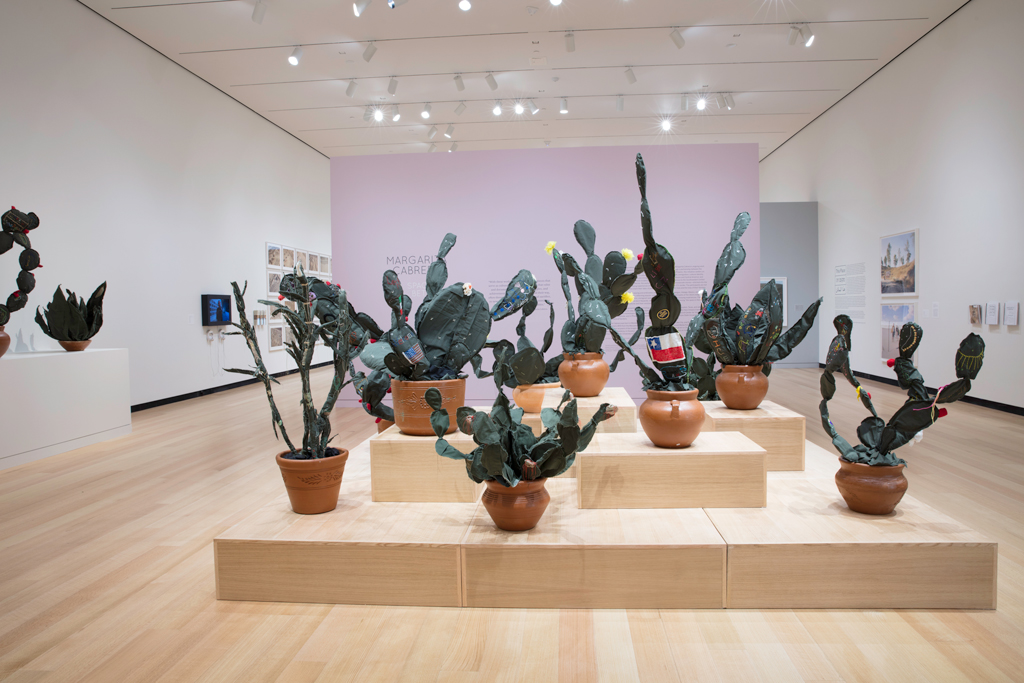[ad_1]
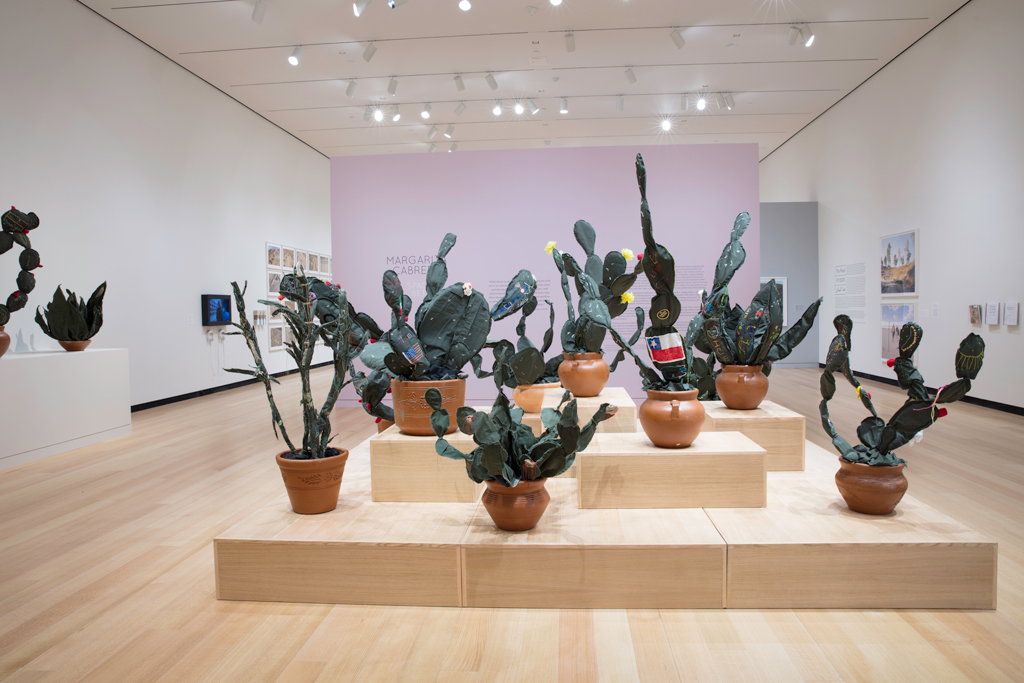
Installation view of “Margarita Cabrera: Space in Between,” 2018, at Wellin Museum of Art, Hamilton College, Clinton, New YOrk.
©WELLIN MUSEUM OF ART, ALL RIGHTS RESERVED
Several years ago, a mother and her two children attempted to cross the Rio Grande over the border from Mexico into the United States. The river’s current is notoriously strong—in Mexico the waterway’s name swaps “grande” for “bravo,” which means “fierce” or “wild.” During their crossing, the mother was forced to use one of her hands to grab, with all her strength, onto a carrizo, a reed native to the region commonly found on the banks of the river; her other hand held onto the first child, who in turn clutched onto the second. For many, the carrizo plant represents a struggle between life and death. The mother would soon understand that struggle: at one point, the river’s current became too strong, and the second child was taken by the relentless waters.
That carrizo—and the story of the mother and her lost child—would come to inspire a sculpture, part of a larger series of work called “Space in Between,” by the Arizona-based artist Margarita Cabrera, who is currently the subject of an exhibition at the Wellin Museum of Art at Hamilton College in Clinton, New York. The mother’s narrative, though, is not part of Cabrera’s own personal history—it belongs to a participant in one of the artist’s community-based embroidery workshops, which she organizes around the Southwest and elsewhere to create soft sculptures constructed out of fabric and placed in terra cotta pots.
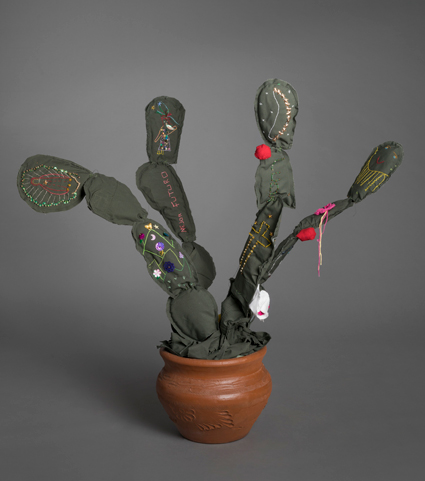
Margarita Cabrera, Space in Between – Nopal (Lucia Fernandez), 2016, border patrol uniform fabric, copper wire, thread, and terra cotta pot.
COLLECTION OF THE ARTIST
The sculptures, made from U.S. Border Patrol uniforms sourced from flea markets, take the form of various plants found across the American Southwest—cacti, aloe vera, agave, carrizo. The fabric’s blooms appear to spiral out of their vessels. Sewn into them are colorful pictograms of homes, people, national flags, the Virgin Mary, doves, hearts, crosses, the sun, the moon, stars, and the word “familia.” Such images contrast with the charged meanings behind the Border Patrol uniforms, which denote various things for various people: either “security, safety, a sense of control,” Cabrera said in an interview, or the opposite, “resistance, restriction, violence, fear—death, even.”
Cabrera’s workshops are more than just a means for the production of artworks. They bring together immigrants with other members of local communities, and begin with charlas, conversations that allow for the sharing of their stories, both the deeply painful ones—of border crossings and the death and estrangement from family that can follow—and the joyful ones—of survival, perseverance, and success.
“The stories surrounding this project are really the heart of the piece because stories represent us, represent important moments in our lives,” Cabrera said. “In order to tell a story, we need to be able to listen to someone telling their story. Listening is very important.”
Cabrera, who is herself an immigrant from Mexico, began her workshop project in 2010 in Texas, as a way to foster a dialogue between recently-arrived immigrants and more established ones. Later, she brought in other groups to participate in the workshops, which have been staged in New Mexico, North Carolina, and, most recently, in Phoenix, Arizona. Cumulatively, the workshops have produced upwards of 100 sculptures. In Phoenix, she partnered with the Arizona State University Art Museum and the city’s Desert Botanical Garden to stage workshops that convened people from the state’s immigrant communities and the more well-to-do supporters of the garden. Her aim was to have them work together to create the sculptures, with the hopes of reaching a better understanding of each other—of the “other.”
“[The groups] were willing to take that step to get to know each other, to work together and transform these materials into something new,” Cabrera said of the Phoenix workshop. “When that happened, there was dialogue, an exchange of childhood histories, an exchange of immigration stories—from both sides.”
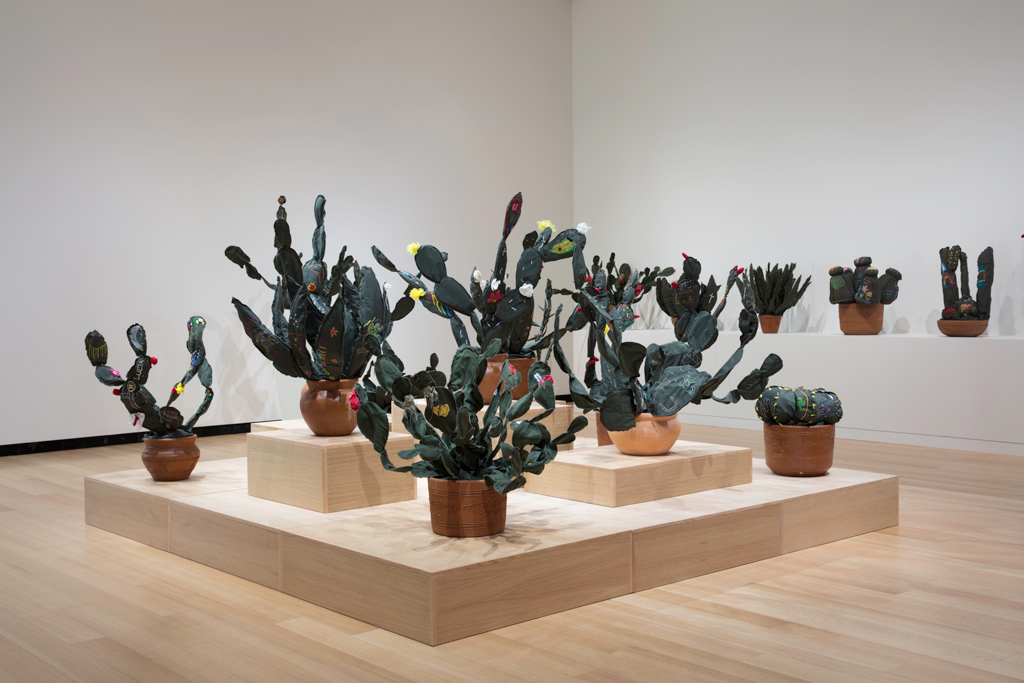
Installation view of “Margarita Cabrera: Space in Between,” 2018, at Wellin Museum of Art, Hamilton College, Clinton, New YOrk.
©WELLIN MUSEUM OF ART, ALL RIGHTS RESERVED
Cabrera conceived her project at a time when the national conversation around immigration and borders had been reignited, particularly in the Southwest. In 2010, Arizonans became embroiled in a heated national debate about their state’s Senate Bill 1070, which required local police to ask for papers of anyone suspected to be in the country illegally. The law became the strictest anti-illegal immigration law in the country at the time and was seen by its critics as disproportionately targeted at the state’s Latinx population. Though a 2016 settlement softened some of the law’s policies, the effects of the conversations surrounding that bill are still felt, both in Arizona and around the whole of the United States.
“Over the years, since 2010, we have projected a kind of resistance to our immigrant communities that I do believe is unfortunate,” said Cabrera, who uses “our” as a way of denoting a shared responsibility for immigrants in this country. “I think these are energies of fear.” With the “Space in Between” series, Cabrera aims to act against those fears surrounding the influx of people to America, by offering “opportunities for us to create new bonds, create relationships, transform our ways of thinking and being with each other through a creative process.”
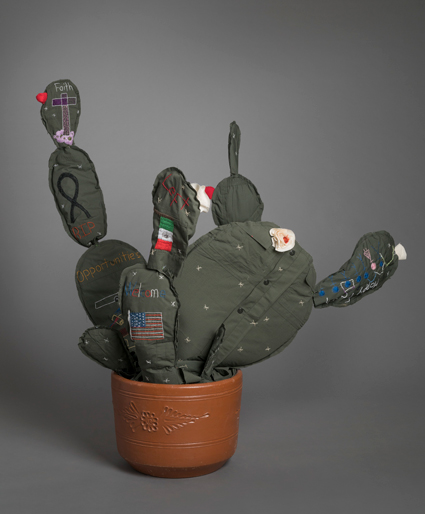
Margarita Cabrera, Space in Between – Nopal (Sara Hernandez), 2016, border patrol uniform fabric, copper wire, thread, and terra cotta pot.
COLLECTION OF THE ARTIST
Cabrera’s optimism—her firmness that her project could alter people’s mindsets—is what made Tracy L. Adler, the Wellin Museum’s director, want to organize a show of her work. “Part of our mandate is to talk about things that are important today and also to give a platform to those artists who are bringing about change through their work,” Adler said. Cabrera’s work “breaks down these monolithic issues—of immigration, of building a wall on the U.S.-Mexico border—to being about people. These are people’s stories, and I think that’s what Americans need to know. It’s about individual stories.”
Stories of immigration can be universal, particularly in America, which Cabrera is quick to note was founded by immigrants. For her project, she has combined that aspect of U.S. history with the concept of nepantla, a Nahutla word used by the Aztecs to mean “the space in the middle.” Nepantla was famously taken up by the Chicana writer and poet Gloria Anzaldúa, who theorized, in her seminal 1987 autobiographical text Borderlands/La Frontera: The New Mestiza, that the concept was related to the idea of “the Borderlands,” or “wherever two or more cultures edge each other, where people of different races occupy the same territory, where under, lower, middle and upper classes touch, where the space between two individuals shrinks with intimacy.” Anzaldúa wrote that the Borderlands are the opposite of borders, which “distinguish us from them.”
“We need to know that [immigration] is part of our shared history, so nepantla allows for that common space to become exposed and to become acknowledged,” said Cabrera, who drew on the Anzaldúa text for “Space in Between.” “It opens up this energy for people to be more open-minded about what I want to invite them to experience.”
Space of the kind is difficult to define, Cabrera said. It’s mythical and spiritual, imagined but somehow real, and it exists between geographies, cultures, jobs, friendships, and more. But however elusive it may be, Cabrera said, such space is real, and understanding it is necessary for uniting us and bringing about change. “It’s hard to put your finger on it, but [nepantla] is there, and if we can tap into that, then we can be more connected,” she said. “It is possible that we can change our ways of thinking toward each other.”
[ad_2]
Source link

